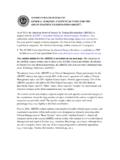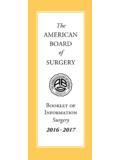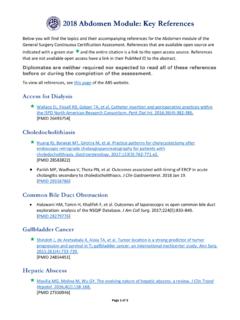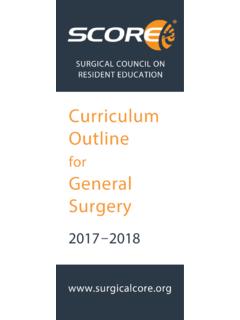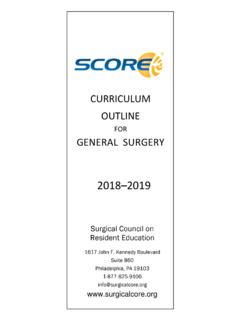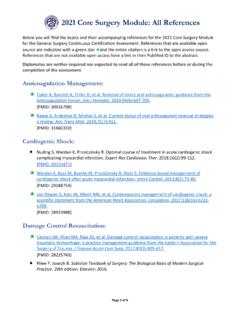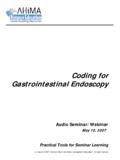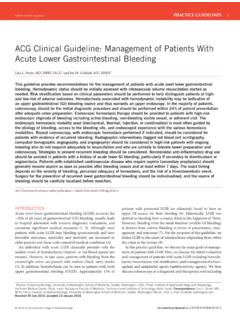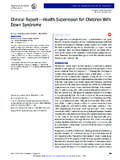Transcription of THE AMERICAN BOARD OF SURGERY
1 THE AMERICAN BOARD OF SURGERY FLEXIBLE ENDOSCOPY CURRICULUM FOR GENERAL SURGERY RESIDENTS Table of Contents (click to go to section) ABS Flexible Endoscopy Curriculum .. 2 LEVEL 1 (PGY-1 or -2) .. 4 LEVEL II (PGY-1 or -2) .. 5 LEVEL III (PGY-2 or -3) .. 6 LEVEL IV (PGY-3 or -4) .. 8 LEVEL V (PGY-4 or -5) .. 9 Appendices - Resources APPENDIX A Suggested Cognitive and Technical Resources by Level .. 10 APPENDIX B Additional Recommended Readings .. 22 APPENDIX C GAGES Scoresheets .. 26 The AMERICAN BOARD of SURGERY gratefully acknowledges the contributions of the following organizations to this curriculum: Society of AMERICAN Gastrointestinal and Endoscopic Surgeons, AMERICAN Society of Colon and Rectal Surgeons, AMERICAN Society for Metabolic and Bariatric SURGERY , and Society for SURGERY of the Alimentary Tract. 2014 The AMERICAN BOARD of SURGERY Inc. Note: SCORE resources in Appendix A updated in May 2017 ABS Flexible Endoscopy Curriculum 2 ABS Flexible Endoscopy Curriculum Overview: The Flexible Endoscopy Curriculum (FEC) is designed to provide general SURGERY training programs with a stepwise, milestone-based curriculum that includes both didactic and hands-on training.
2 Upon the successful completion of this curriculum, a general SURGERY resident will possess the knowledge and skill to be a surgical endoscopist with the ability to provide endoscopic services to patients in any clinical setting. Purpose: Upon completion of this curriculum, a general SURGERY resident will have the knowledge and technical skill to manage commonly encountered gastrointestinal (GI) diseases and conditions using flexible endoscopy. Definition: A surgical endoscopist is a surgeon who has the knowledge and technical skill to use flexible endoscopy to provide care for patients with common gastrointestinal diseases. This ability includes: understanding of the indications and contraindications for performing upper andlower recognition and management of normal and abnormal findings in the GI and management of complications from performing GI performance of upper and lower endoscopy including complete navigation of theesophagus, stomach, proximal duodenum, and inspection and recognition of lesions that may require acquisition using biopsy or of periprocedural of a percutaneous endoscopic gastrostomy (PEG)Structure: This curriculum is intended to be completed during general SURGERY residency training.
3 It is designed with the recognition that flexible endoscopy is only one component of an entire surgical residency, and therefore care has been taken to not overwhelm the resident or program director, but rather, to provide a stepwise curriculum with both cognitive (didactic) and technical (hands-on) milestones for each level of residency. These milestones may be completed earlier in residency training than is outlined in this document, but should not be completed any later than described. We strongly recommend completing this curriculum by PGY-4 to maximize learning and skills acquisition. Programs should track residents progress by documenting when each level of the curriculum is completed. Existing off-the-shelf educational resources are listed for the cognitive content, and a variety of options are given for obtaining hands-on skills. Proficiency-based performance metrics are also built into the curriculum to provide a more accurate basis of technical mastery beyond simply counting case numbers.
4 Back to TOCABS Flexible Endoscopy Curriculum 3 Required Resources: This curriculum assumes that each surgical residency program has available to it experts in flexible GI endoscopy. These experts may be surgical endoscopists or gastroenterologists, although it is expected over time that the program will recruit or train surgical endoscopists to conduct the training of SURGERY residents. Training programs should also have flexible endoscopy simulators (inanimate, animate or computer-based) available as part of its skills training lab. Finally, each residency program should provide a concentrated clinical rotation in flexible GI endoscopy. The duration of this rotation may vary, but it is recommended for it to be at least one month in length. During this rotation, residents should participate in the evaluation and management of patients with GI diseases as well as perform endoscopic procedures. This concentrated clinical rotation in flexible GI endoscopy may be embedded in a GI or general surgical rotation, such as upper GI SURGERY , colorectal SURGERY , or rural SURGERY , provided there is a sufficient volume of endoscopy to satisfy the requirements of this curriculum and an endoscopist who will be accountable for the quality of the experience.
5 Back to TOCABS Flexible Endoscopy Curriculum Level I LEVEL I (Typically completed in PGY-1 or -2) The majority of the early stages of this curriculum are dedicated to didactic materials so as to provide a basic understanding of GI diseases and the anatomy of the GI tract as perceived by flexible endoscopic techniques. The modules available on the SCORE Portal (Surgical Council on Resident Education; ) are an excellent source for this material and relevant SCORE content has been mapped to the curriculum and provided in Appendix A. The hands-on portion involves simulation-based training using either inanimate models, computer-generated simulation, or a clinical tutorial experience geared toward the novice resident. Further clinical exposure to flexible endoscopy will occur after this initial introduction to basic scope mechanics. Cognitive Milestones: Basic understanding of GI diseases and endoscopic GI anatomy Materials: Recommended materials for this level are found in Appendix A Technical Milestones: Simulation or clinical tutorial exposure with an emphasis on basic scope manipulation including one-handed wheel deflection, control of suction, irrigation, and insufflation, and passage of instruments through the working channel Equipment: 1.
6 Inanimate trainers used with real endoscopes 2. Virtual reality endoscopy simulators (if available) Recommended equipment for this level are found in Appendix A Back to TOCABS Flexible Endoscopy Curriculum Level II 5 LEVEL II (Typically completed in PGY-1 or -2) The cognitive milestones in this level focus on understanding flexible endoscope function, including setup, troubleshooting, and maintenance of the equipment. Residents may also continue training with simulation tools or, alternatively, a clinical tutorial may serve for learning these functions. Cognitive Milestones: Basic understanding of flexible endoscope function 1. Characteristics of endoscopes a. Fiberoptic components b. Videoendoscopic components c. Image capture d. Channels e. Tip control 2. Equipment setup a. Cart b. Umbilical cable c. Equipment setup steps d. Equipment testing 3. Troubleshooting 4. Equipment care a. Maintenance b. Cleaning Materials: Recommended materials for this level are found in Appendix A Technical Milestones: Simulation or clinical exposure with demonstration of proper endoscope setup and function, troubleshooting of common problems, and a continued emphasis on basic scope manipulation Equipment: 1.
7 Inanimate trainers used with real endoscopes 2. Virtual reality endoscopy simulators (if available) Recommended equipment for this level are found in Appendix ABack to TOCABS Flexible Endoscopy Curriculum Level III 6 LEVEL III (Typically completed in PGY-2 or -3) During the junior experience, residents take a direct role in patient preparation, performance of endoscopy, and postoperative management. The cognitive milestones include bowel prep; moderate sedation; identification of pathology; management of findings; complication avoidance; and complication management. A dedicated one-month flexible endoscopy rotation is typically completed during this time, which may be completed on a GI medicine or general surgical service as described earlier under Required Resources. Additional clinical experiences may be added as part of other gastrointestinal surgical rotations. Residents will be trained in basic upper and lower endoscopy, augmenting their endoscopy suite experience with cases in the ICU and operating room.
8 Technical progress is assessed during this block using the Global Assessment of Gastrointestinal Endoscopic Skills (GAGES). GAGES scores should be recorded for residents at baseline and then at least intermittently through the course of their endoscopic experience. The goal is for residents to consistently achieve a GAGES score of 18 during their procedures. There should also be exposure to multidisciplinary GI meetings such as pathology conferences and GI conferences. Cognitive Milestones: Indications and contraindications of upper and lower flexible endoscopy, periprocedural patient management 1. Prepare patient for procedure a. Informed consent b. Bowel preparation c. Management of anticoagulants and antiplatelet medications d. Management of cardiac rhythm devices e. Periprocedural antibiotics 2. Understand principles of moderate sedation 3. Understand the appropriate and safe use of endoscopy a. Indications b. Contraindications c.
9 Recognition and management of normal and abnormal findings Materials: Recommended materials for this level are found in Appendix A Technical Milestones: Simulation exposure or clinical tutorial, dedicated endoscopy experience, intraoperative endoscopy, ICU endoscopy Equipment and Resources: 1. Inanimate trainers used with real endoscopes 2. Virtual reality endoscopy simulators (if available) Back to TOCABS Flexible Endoscopy Curriculum Level III 7 3. Clinical experience a. Dedicated endoscopy rotation b. Intraoperative endoscopy c. ICU endoscopy d. Endoscopy as part of a GI SURGERY service 4. Global Assessment of Gastrointestinal and Endoscopic Skills (GAGES) a. Appendix C Back to TOCABS Flexible Endoscopy Curriculum Level IV 8 LEVEL IV (Typically completed in PGY-3 or -4) This initial senior experience encompasses improvements in both cognitive and technical skills with cases assessed using GAGES to achieve a minimum score of 18 for both upper and lower endoscopy a score achieved by experienced endoscopists during the GAGES validation studies.
10 Residents continue with more advanced cognitive modules for therapeutic endoscopic techniques. Clinical experience for residents, outside of their dedicated endoscopy experience, should take place in the operating room and ICU, and continued work in the endoscopy suite of the home institution or other affiliated or associated institutions is encouraged. Cognitive Milestones: Image differentiation of normal/abnormal pathology, understanding intraoperative and postoperative GI anatomy, appropriate use of endoscopy 1. Recognition and management of complications 2. Outcomes measures Materials: Recommended materials for this level are found in Appendix A Technical Milestones: Intraoperative endoscopy, ICU endoscopy, continued endoscopic experience Requirement: Endoscopy cases assessed using GAGES to achieve a minimum score of 18 (Appendix C) Back to TOCABS Flexible Endoscopy Curriculum Level V 9 LEVEL V (Typically completed in PGY-4 or -5) This part of the senior experience prepares the resident for postgraduate clinical practice in endoscopy with exposure to the tools/adjuncts for therapeutic endoscopic interventions.
